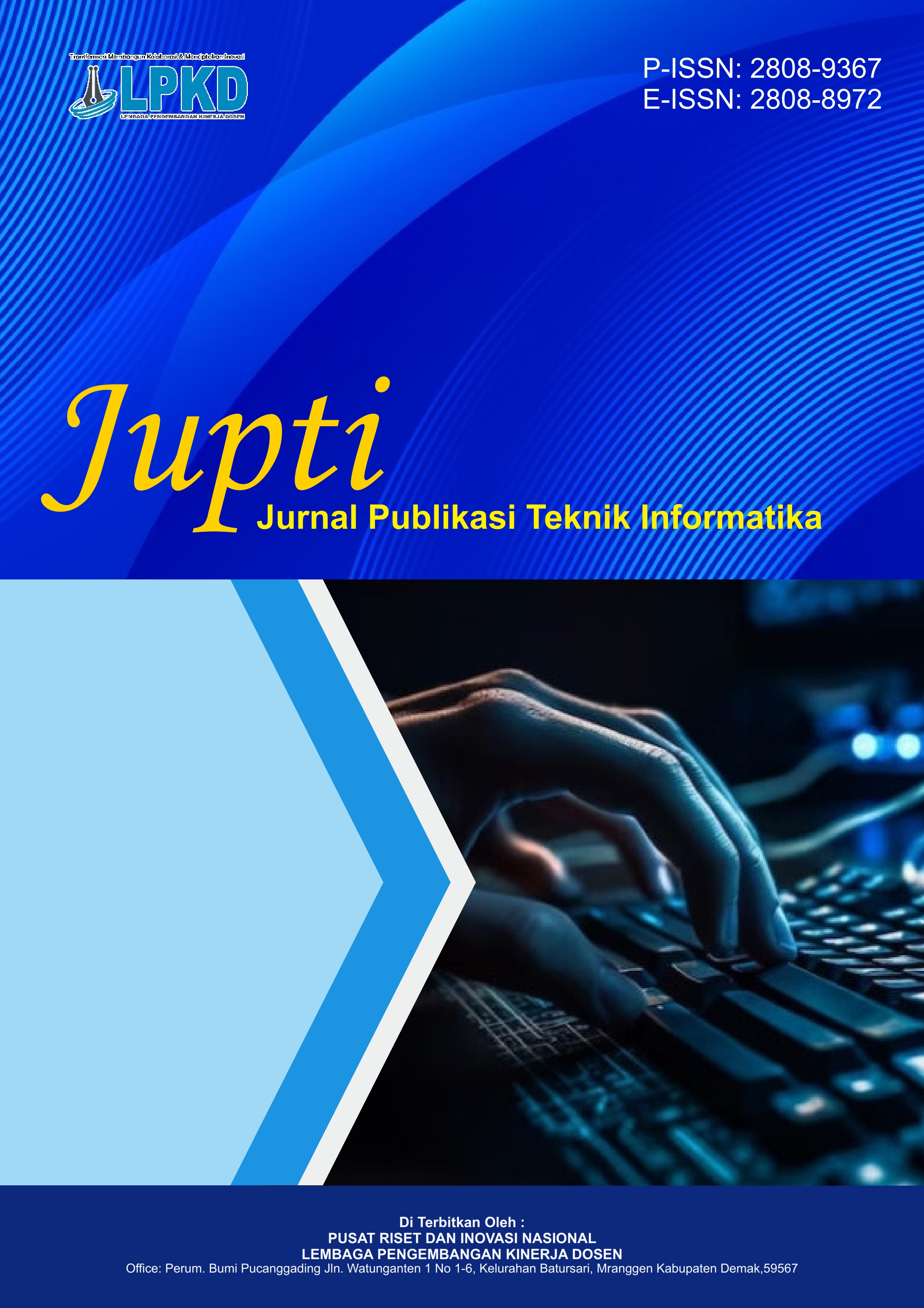Pemanfaatan Game Scratch sebagai Media Pembelajaran Interaktif di SD Inpres Waharia
DOI:
https://doi.org/10.55606/jupti.v4i3.5577Keywords:
STMIK Pesat Nabire, Interactive, Learning media, Learning motivation, ScratchAbstract
Low student learning motivation in conventional teaching remains a major challenge in elementary education, especially in regions with limited access to educational technology. This study aims to develop and evaluate the effectiveness of interactive learning media based on games created with the Scratch application to improve learning motivation among fourth-grade students at SD Inpres Waharia. The research employed a Research and Development (R&D) approach with a prototyping model, encompassing stages of needs analysis, media design, prototyping, implementation, and evaluation through limited trials. Data collection involved student engagement observations, teacher interviews, and validation sheets from media and subject experts. The results indicated that the use of Scratch significantly enhanced students’ attention and active participation, creating a more enjoyable and engaging learning atmosphere. Teachers acknowledged that the media supported visual and interactive material delivery, accelerating students’ understanding of key concepts. Therefore, Scratch-based media is a promising alternative for innovative learning tools, aligning with 21st-century educational needs and supporting digital transformation policies in elementary education.
References
Anggarwati, H., Muslim, A. B., & Marzuki, M. (2022). The development education game learning media of Pancasila and citizenship education subject to increase learning motivation. https://doi.org/10.2991/978-2-494069-67-1_10
Ayuso, Á. M., Adamuz-Povedano, N., Bracho-López, R., & Vicaria Torralbo, M. (2023). Computational thinking with Scratch: A tool to work on geometry in the fifth grade of primary education. Sustainability, 16(1), 110. https://doi.org/10.3390/su16010110
Badawi, A., Kurniawan, A. R., & Setyawati, H. (2023). Efforts to improve learning motivation and learning outcomes throw in the game softball through traditional games. Journal of Education Action Research, 7(3). https://doi.org/10.23887/jear.v7i3.62542
Budiarto, F., & Jazuli, A. (2021). Interactive learning multimedia improving learning motivation elementary school students. Proceedings of the 2021 EAI International Conference. https://doi.org/10.4108/eai.19-7-2021.2312497
Dabbous, M., Kawtharani, A., Fahs, I., Hallal, Z., Shouman, D., Akel, M., Rahal, M., & Sakr, F. (2022). The role of game-based learning in experiential education: Tool validation, motivation assessment, and outcomes evaluation among a sample of pharmacy students. Education Sciences, 12(7), 434. https://doi.org/10.3390/educsci12070434
Ghimby, D., & Fajarini, A. (2022). Development of interactive multimedia-based learning media for social studies subjects at SMP Negeri 2 Gending Probolinggo. Solidarity, 2(1), 88. https://doi.org/10.35719/solidarity.v2i1.88
Girard, C., Écalle, J., & Magnan, A. (2012). Serious games as new educational tools: How effective are they? A meta‐analysis of recent studies. Journal of Computer Assisted Learning, 28(3), 207–219. https://doi.org/10.1111/j.1365-2729.2012.00489.x
Gordillo, A., López-Fernández, D., & Tovar, E. (2022). Comparing the effectiveness of video-based learning and game-based learning using teacher-authored video games for online software engineering education. IEEE Transactions on Education, 65(4), 451–460. https://doi.org/10.1109/TE.2022.3142688
He, Q., Yang, J., Chen, H., Liu, J., Ji, Q., Wang, Y., & Tang, F. (2021). Evaluation of extreme precipitation based on three long‐term gridded products over the Qinghai‐Tibet Plateau. Remote Sensing, 13(15), 3010. https://doi.org/10.3390/rs13153010
Iasha, V., Sumantri, M. S., Sarkadi, S., & Rachmadtullah, R. (2018). Development media interactive learning in education Pancasila and citizenship education to improve tolerance of students in elementary school. Proceedings of the 2018 Advances in Economics, Business and Management Research Conference. https://doi.org/10.2991/acec-18.2018.71
Ilić, J., Ivanović, M., & Klašnja‐Milićević, A. (2024). Effects of digital game-based learning in STEM education on students' motivation: A systematic literature review. Journal of Baltic Science Education, 23(1), 20–35. https://doi.org/10.33225/jbse/24.23.20
Kalelioğlu, F., & Gülbahar, Y. (2014). The effects of teaching programming via Scratch on problem solving skills: A discussion from learners' perspective. Informatics in Education, 13(1), 33–50. https://doi.org/10.15388/infedu.2014.03
Li, Y., Chen, D., & Deng, X. (2024). The impact of digital educational games on students’ motivation for learning: The mediating effect of learning engagement and the moderating effect of the digital environment. PLOS ONE, 19(1), e0294350. https://doi.org/10.1371/journal.pone.0294350
Maloney, J., Resnick, M., Rusk, N., Silverman, B. S., & Eastmond, E. (2010). The Scratch programming language and environment. ACM Transactions on Computing Education, 10(4), 16. https://doi.org/10.1145/1868358.1868363
Rakasiwi, C. W., & Muhtadi, A. (2021). Developing educational games for mathematics learning to improve learning motivation and outcomes. JTP: Jurnal Teknologi Pendidikan, 23(1), 30–42. https://doi.org/10.21009/jtp.v23i1.18356
Sáez López, J. M., Román González, M., & Vázquez Cano, E. (2016). Visual programming languages integrated across the curriculum in elementary school: A two-year case study using Scratch in five schools. Computers & Education, 97, 129–141. https://doi.org/10.1016/j.compedu.2016.03.003
Sailer, M., & Homner, L. (2019). The gamification of learning: A meta-analysis. Educational Psychology Review, 32(1), 77–112. https://doi.org/10.1007/s10648-019-09498-w
Sarifah, I., Nugroho, A., Marini, A., Yarmi, G., Safitri, D., & Dewiyani, L. (2023). Scratch-based interactive games to increase interest in learning mathematics for the second grade elementary school students. Jurnal Pendidikan dan Pengajaran, 56(2), 158–168. https://doi.org/10.23887/jpp.v56i2.66556
Satria, E., Efendi, G., Makmur, Z., Sofarina, S., & Daswarman, D. (2023). Pengembangan media interaktif pemograman berpikir komputasional. Journal on Teacher Education, 4(3), 12554. https://doi.org/10.31004/jote.v4i3.12554
Sumarsono, S. H., Sabri, I., & Suryandoko, W. (2024). Peningkatan kreativitas dalam pembelajaran seni budaya melalui pemanfaatan multimedia interaktif. JIIP: Jurnal Ilmiah Ilmu Pendidikan, 7(2), 3712. https://doi.org/10.54371/jiip.v7i2.3712
Winarko, G. C. (2024). Project-based learning with Scratch to improve students’ creative thinking ability: Systematic literature review. Griya Journal of Mathematics Education and Application, 4(2), 440. https://doi.org/10.29303/griya.v4i2.440
Yu, Z., Ming-le, G., & Wang, L. (2020). The effect of educational games on learning outcomes, student motivation, engagement and satisfaction. Journal of Educational Computing Research, 58(7), 1353–1376. https://doi.org/10.1177/0735633120969214
Zhu, Y., Jing, L., Hu, R., Mo, F., Jia, Q., Yang, G., Xu, Z., Han, M., Wang, M., Cai, X., & Luo, J. (2024). High-throughput microelectrode arrays for precise functional localization of the globus pallidus internus. Cyborg and Bionic Systems, 5, 0123. https://doi.org/10.34133/cbsystems.0123
Downloads
Published
How to Cite
Issue
Section
License
Copyright (c) 2025 Jurnal Publikasi Teknik Informatika

This work is licensed under a Creative Commons Attribution-ShareAlike 4.0 International License.








